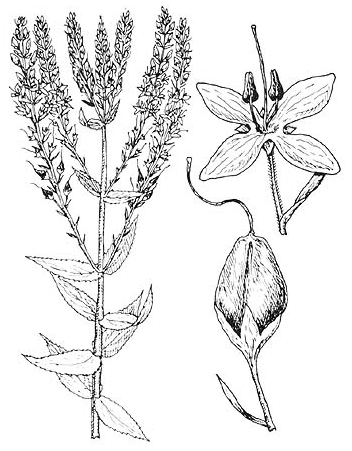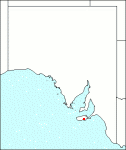Family: Plantaginaceae
Parahebe derwentiana
Citation:
B. Briggs & Errend., Taxon 17:742 (1968).
Synonymy: Veronica derwentiana Andrews, Bot. Rep. 8:t. 531 (1808) as "derwentia" in error; V. labiata R. Br., Prod. Fl. Nov. Holl. 434 (1810).
Common name: Derwent speedwell, white veronica.
Description:
Perennial with long erect to ascending branches to 2 m high, glabrous but for a patch of straight or irregularly curled eglandular hairs at and below the nodes and a row of sparse or dense antrorsely curved white eglandular hairs on the rhachis decurrent from either side of the bracts and sometimes on the pedicel; leaves connected across the node by a ridge, sessile, ovate, 4-14.5 x 1.2-4 cm, with the margin regularly or irregularly, densely or coarsely serrate, narrowly recurved, long-acuminate.
Inflorescences long dense axillary racemes forming a corymb at each branch end; bracts much shorter than the leaves, linear, 2-9 mm long, entire; pedicels shorter than the subtending bract, 3-7 mm long in fruit; sepals 4, triangular, 1.5-3 mm long, fused in the basal quarter; corolla wrote, pale-blue or pale-mauve, pubescent in the tube, with 4 more or less equal, acute to acuminate lobes 3-5 mm long; stamens with filaments flat for the most part, two-thirds the length of the corolla lobes, the anthers broad, 1-1.3 mm long.
Capsule ovoid, somewhat compressed, c. 3.5 x 2.6 mm and obtuse in lateral view, septicidal and simultaneously or incompletely loculicidal, with a fine ridge down the centre of each valve, broadly channelled between them, with a slender deciduous style 4.5-5.5 mm long.

| Flowering branch, flower and fruit.
|
Image source: fig. 595B in Jessop J.P. & Toelken H.R. (Ed.) 1986. Flora of South Australia (4th edn).
|
Published illustration:
Burbidge & Gray (1970) Flora of A.C.T., fig. 335.
|
|
Distribution:
|
Beside streams and waterfalls or associated with limestone caverns.
N.S.W.; Vic.; Tas.
|
Conservation status:
native
Flowering time: Oct. — Jan. (March).
|

SA Distribution Map based
on current data relating to
specimens held in the
State Herbarium of South Australia
|
Biology:
Now rare in S.Aust. The second SE location is based on a sighting in 1983 by D. N. Kraehenbuehl. The species is polymorphic in the toothing of the foliage, with 3 of the unpublished subspecies recognised by B. Briggs and F. Ehrendorfer occurring in this State.
Author:
Not yet available
|

